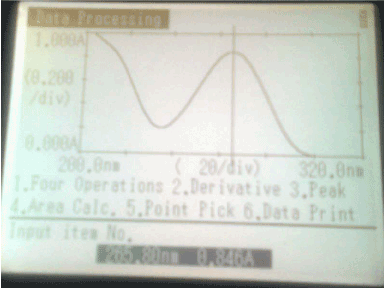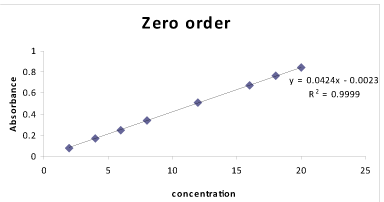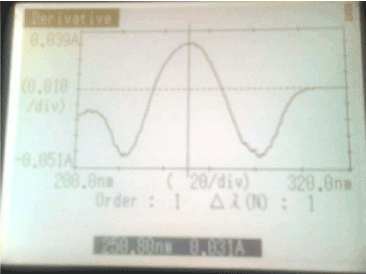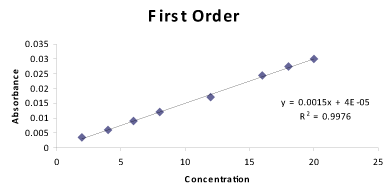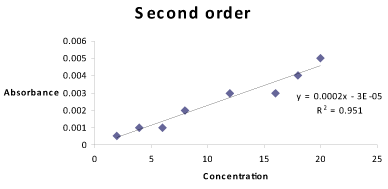| Research Article |
Open Access |
|
| Kajal Ghosal* |
| Department of Pharmaceutical Technology, Jadavpur University, Durgapur, India |
| *Corresponding authors: |
Kajal Ghosal
Department of Pharmaceutical Technology
Jadavpur University, Durgapur, India
E-mail: kaju_3_ju@rediffmail.com |
|
| |
| Received August 18, 2012; Published September 25, 2012 |
| |
| Citation: Ghosal K (2012) UV-Spectroscopic Methods for Estimation of Stavudine: Finding the Best Order. 1:355. doi:10.4172/scientificreports.355 |
| |
| Copyright: © 2012 Ghosal K. This is an open-access article distributed under the terms of the Creative Commons Attribution License, which permits unrestricted use, distribution, and reproduction in any medium, provided the original author and source are credited. |
| |
| Abstract |
| |
| In this present work, UV spectrophotometer derivatives such as zero-order, first-order and second order were studied to establish the most simple, accurate, precise and sensitive method for quantitative determination of Stavudine in pharmaceutical preparation, The concentration range of stavudine for analysis was chosen from 2 to 20 mcg ml. In zero order spectrophotometry, absorbance values were measured at 265 nm. For first order spectrophotometry, absorbance values were measured at 250.8 nm and in case of second order derivative spectrophotometry, the absorbance values were measured at 232.8 nm. All measurements were done in the range of 210 to 310 nm in distilled water. According to international conference on Harmonization (ICH) Guidelines, parameters such as correlation coefficient, Sandel’s sensitivity, limit of quantitation (LOQ) & limit of detection (LOD) were studied. Zero-order has shown highest correlation coefficient with lowest values of sandel’s sensitivity, LOD and LOQ whereas Second-order derivative has shown the maximum values of Sandel’s sensitivity, LOD and LOQ. So the zero order method is best for the estimation of Stavudine in bulk pharmaceutical dosage form in comparison to other two order derivatives. |
| |
| Keywords |
| |
| Stavudine; Zero-order; First-order; Second-order |
| |
| Introduction |
| |
| For the treatment of Acquired Immuno Deficiency Syndrome (AIDS): Five classes of anti-retroviral drugs (ARV) have been developed such as nucleoside reverse transcriptase inhibitors (NRTIs), non-nucleoside reverse transcriptase inhibitors (NNRTIs), protease inhibitors (PIs), entry or fusion inhibitors and integrase inhibitors. Human immunodeficiency virus (HIV) gradually progressed to AIDs that lead to morbidity and mortality. To minimize the risk of this HIV, a combination of these ARV drugs are vital. For resourcelimited countries, a combination of two NRTIs with an NNRTI is the recommended for first line regimen. The commonly used NRTIs are Zidovudine, Stavudine and Lamivudine, while Nevirapine and Efavirenz are frequently used as NNRTIs. |
| |
| Stavudine is a thymidine analogue with activity against HIV I. The chemical name of Stavudine is 2’3’deoxythymidine. Its molecular formula is C10H12N2O4 and molecular weight is 224.22g /mol. The structure of Stavudine is given in Figure 1. |
| |
|
|
Figure 1: Structure of Stavudine. |
|
| |
| Stavudine is a powder, white or almost white in colour .It is freely soluble in water. In USP Monograph it is officially listed. By HPLC, Titrimetry & UV visible spectrophotometry, Stavudine can be estimated in biological fluid or pharmaceutical formulation. |
| |
| Numerous analytical methods have been developed for determination of Stavudine in dosage form. But UV detection is still widely used for relatively simple bioanalytical assays. Derivative spectroscopy (4, 5, 6, 7) is an important analytical tool which can be used for extracting both qualitative and quantitative information from spectra composed of unresolved bands. However to our knowledge, it has been shown from two research works (4, 5) that both first-order and second-order UV spectroscopic methods are suitable, accurate and precise for the quantification of stavudine. So it was aimed here to compare the zero, first and order and to find out the most appropriate and suitable spectrophotometric order. All optimization parameters were considered for all three spectroscopic methods [1-3]. |
| |
| Materials and Methods |
| |
| Stavudine was obtained from Arabinda Pharma, Hyderabad (India). Distilled water was used for the preparation of solutions. |
| |
| Instruments |
| |
| A thermospectronic double beam UV-1800 Shimadzu with UV- 1800 ENG 240V Software was used. Zero, first, second order, reference and sample solution were recorded in 1cm. Quartz cells at a scan speed of 600 nm./min., a scan range of 210-310 nm and fixed slit width of 2 nm. |
| |
| Preparation of stock solution |
| |
| 100 mg of standard Stavudine drug is weighed, transferred to a 100 ml volumetric flask and dissolved in distilled water. The flask was shaken and volume was made up to the mark with distilled water to give a solution containing 1000 μg/ml. From this stock solution, 10 ml solution was pipetted out and transferred into 100 ml volumetric flask. The volume was made up to the mark with distilled water to give a solution containing 100 μg/ml. |
| |
| Selection of Analytical concentration ranges |
| |
| From the standard stock solution of stavudine, appropriate aliquots were pipetted out into 10ml volumetric flask and dilutions are made with distilled water to obtain working standard solutions of concentrations from 2 to 20 mcg/ml. Absorbance of these solutions are measured at 265 nm., 250.8 nm., and 232.8 nm. For the standard solutions, analytical concentration ranges are 2-20 μg/ml. |
| |
| Limits of detection (LOD) and limits of quantitation (LOQ) |
| |
| The LOD and LOQ of Stavudine are determined by using calibration standards. Value of LOD is determined by using the formula: 3.3á/S |
| |
| And the value of LOQ is determined by: 10á/S , where ‘á ‘ is the standard deviation of the y intercept of the regression equation and ‘S’ is the slope of calibration curve. |
| |
| Data analysis |
| |
| All the statistical data analysis was done by statistical product and service solutions (SPSS) at a significance level (p) of 0.05 |
| |
| Results |
| |
| Zero-Order UV Spectroscopy |
| |
| By scanning of the solution of Stavudine in distilled water from the range of 200-320 nm, one maxima was obtained in zero order UV spectra (Figure 2). This is 265 nm. By plotting (Figure 3) the absorbance values versus ten different concentrations of standard solutions, calibration curve was obtained. |
| |
|
|
Figure 2: Zero-order Spectra of Stavudine at 265 nm. |
|
| |
|
|
Figure 3: Linearity curve for Stavudine at 265 nm by zero-order spectroscopy. |
|
| |
| According to Beer’s Law, the linearity range was found to be 2.0 - 20.0 microgram/ml in the method. |
| |
| |
| The LOQ was 0.438 mcg/ml and LOD was 0.144 mcg/mL. The regression equation and correlation coefficient were determined. The different parameters are shown in Table 1. Sandell’s sensitivity and correlation coefficients were found to be 0.025 and 0.9997. |
| |
|
|
Table 1: Optical characteristics of Stavudine. |
|
| |
| First-Order derivative UV spectrophotometry |
| |
| In the first derivative spectra, the standard solutions of Stavudine in distilled water was scanned in the range of 220–320 nm (Figure 4) and it was found that there was one maxima at 250 nm. |
| |
|
|
Figure 4: First-order Spectra of Stavudine at 250 nm. |
|
| |
| Measuring wave length range and n values (smoothing factor) are the determinants of the derivative wavelength difference. Generally the noise can be decreased by increasing wavelength range. A series of smoothing factor (n varies from 1 to 9) was tried in first-order spectroscopy. When the value of n is 2, one sharp peak at 250 nm was found and the ration of signal/noise elevates and the sensitivity of that peak increases. |
| |
| By measuring the absorbance of the different concentration solutions (2 to 20 mcg/ml), one calibration curve was plotted (Figure 5). |
| |
|
|
Figure 5: Linearity curve for Stavudine at 250 nm by First-order spectroscopy. |
|
| |
| The determination of Stavudine can be done by the calibration curve. |
| |
| According to Beer’s Law, the linearity range was found to be 2.0- 20.0 microgram/ml in the method. |
| |
| The LOQ was 0.707 mcg/ml and LOD was 0.156 mcg/mL. |
| |
| The regression equation and correlation coefficient were determined. The different parameters are shown in Table 2. Sandell’s sensitivity and correlation coefficients were found to be 0.5714 and 0.997. |
| |
|
|
Table 2: Optical characteristics of Stavudine. |
|
| |
| Second order derivative UV Spectrophotometry |
| |
| In the second derivative spectra, the different concentration solutions of Stavudine in distilled water was scanned in the range of 220 – 320 nm and one maxima was found at 232 nm (Figure 6). |
| |
|
|
Figure 6: Second-order Spectra of Stavudine at 232 nm. |
|
| |
| Measuring wave length range and n values (smoothing factor) are the determinants of the derivative wavelength difference for second order derivative spectra also. A series of smoothing factor (n varies from 1 to 9) was tried in second-order spectroscopy. When the value of n is 4, one sharp peak at 232 nm was found and the ration of signal/noise elevates and the sensitivity of that peak increases. |
| |
| By measuring the absorbance of the different concentration solutions (2 to 20 mcg/ml), one calibration curve was plotted (Figure 7). The determination of Stavudine can be done by the calibration curve. |
| |
|
|
Figure 7: Linearity curve for Stavudine at 232 nm by second-order spectroscopy. |
|
| |
| The LOQ was 3.53 mcg/ml and LOD was 1.16 mcg/mL. |
| |
| The regression equation and correlation coefficient were determined. The different parameters are shown in Table 3. Sandell’s sensitivity and correlation coefficients were found to be 4 and 0.951. |
| |
|
|
Table 3: Optical characteristics of Stavudine. |
|
| |
| Conclusion |
| |
| By observing values of Sandel’s sensitivity, Correlation coefficients, LOD and LOQ for different spectroscopic method, it can be concluded that Zero-order is the best suitable method for quantification of Stavudine in comparison two other two methods. |
| |
| |
| References |
| |
- https://www.rxlist.com/stavudine-drug.htm
- Indian pharmacopoeia (1996) Addendum 2002: 30-31.
- Rockville MD (1985) United States Pharmacopoeia (USP-NF XXIV), United States Pharmacopoeia Convention Inc. 3218.
- Panditi VR, Vinukonda A (2011) Validated First-order derivative spectroscopic method for the determination of stavudine in bulk and pharmaceutical dosage forms. International journal of Chem Tech Research 3: 18-22.
- Panditi VR, Vinukonda A (2011) Development of second order spectroscopic method for the determination of stavudine in bulk and pharmaceutical dosage forms. Journal of Pharmacy research 4: 492-493.
- Unal K, Palabiyik IM, Karacan E, Onur F (2008) Spectrophotometric determination of amoxicillin in pharmaceutical formulations. Turk Pharm Sci 5:1-16.
- Yilmaz B (2008) Determination of Atenolol in Pharmaceutical Preparation by Zero-, First-, Second- and Third-Order Derivative Spectrophotometric Methods. FABAD J PharmSci 33:119–129.
|
| |
| |


